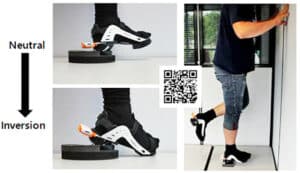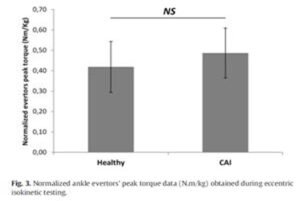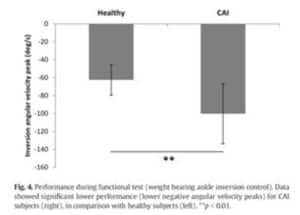Background & Objectives
Ankle sprain is the most common sport-related injury and eccentric weakness of evertor muscles is regarded as a significant muscular deficit related to Chronical Ankle Instability (CAI).
However, the eccentric performance of the evertors in weight bearing is rarely assessed by clinicians: the gold standard is the isokinetic testing, which is not applicable in daily practice (expensive device) and not functional.
One of the aims of Myolux e-volution device is to identify eccentric weakness of evertor thanks to an easy-to-apply functional test, with a higher sensibility than isokinetic testing.


The System Development
The specific and physiological rearfoot destabilization of the Myolux™ concept allows targeted ankle proprioception and strengthening exercises to optimise functional rehabilitation of unstable ankles.
Based on relevant parameters, the Shimmer3 IMU gives information which is used to create a biofeedback for the user (IMU is placed on the rearfoot of a specific and patented mechanical device).
Specific software was developed, a program that takes into account knowledge issued from several years of research about sensorimotor control of stable and unstable ankles-1, 2, 3.

The Study & Results
Two experimental groups: 12 healthy subjects & 12 subjects with CAI (inclusion respects criteria of Gribble et al., 2013). Subjects conduct repetitions of one leg weight bearing ankle inversion on a specific ankle destabilization device (Myolux Medik e-volution™) equipped with a Shimmer3 IMU. Ankle inversion control is performed by means of an eccentric recruitment of evertor muscles. Instructions are to perform, as slow as possible, the ankle inversion while resisting against full body weight applied on the tested ankle.
CAI subjects: –>Ankle evertors weakness through an impaired control of weight bearing ankle Inversion (2).
->Higher angular velocity peaks during one leg ankle inversion control when compared to healthy subjects (2).
60°/s may be the inversion angular velocity threshold differentiating CAI subjects and healthy subjects (2). The Shimmer3 capture the angular velocity associated with the inversion movement.


Conclusion
->Easy-to-apply functional test: More discriminant than isokinetic testing (gold standard) to assess weakness of evertors in patients suffering from CAI.
->To be implemented to objectively monitor improvements during rehabilitation using inversion angular velocity decrease as improvement marker (60°/s threshold).
References
- Gribble, P.A., et al., 2013. Selection criteria for patients with chronic ankle instability in controlled research : a position statement of the international ankle consortium, J. Orthop. Sports Phys. Ther.
- Terrier, R., et al., 2014. Impaired control of weight bearing ankle inversion in subjects with chronic ankle instability, Clin. Biomech.
- Terrier, R., et al., 2016. Assessment of evertor weakness in patients with chronic ankle instability: Functional versus isokinetic testing, Clin. Biomech.

